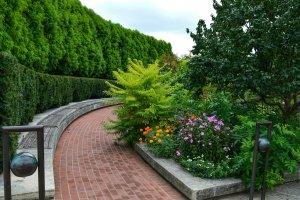Sustainable Landscaping: Eco-Friendly Materials and Design Choices

Reimagining Gardens with a Lighter Footprint
Sustainability isn’t just about what we recycle or how often we use the clothesline. For many homeowners, it’s also becoming a guiding principle in how we shape our outdoor spaces. A sustainable garden doesn’t mean sacrificing style or comfort—it means designing with purpose, selecting materials that last, and creating a landscape that supports the environment rather than working against it.
Choosing Native Plants Over Imports
A sustainable landscape begins with the right plant choices. Native Australian plants are naturally adapted to the local climate and soil conditions, meaning they require far less water, fertiliser, and pest control than exotic species.
Plants like lilly pilly, kangaroo paw, grevillea, and banksia are not only hardy but also attract native birds, bees, and butterflies. This creates a small but meaningful contribution to supporting local biodiversity. Plus, they’re often more drought-tolerant, which is increasingly important in many parts of Australia.
Designing around native species also cuts down on maintenance and long-term costs—a win for both the environment and your budget.
Rethinking Lawn: Smaller, Smarter, or Gone Altogether
Lawns look great in pictures but often demand a lot of water, mowing, fertiliser, and weeding to stay that way. For more eco-conscious landscaping, reducing lawn size or swapping it out for alternatives can make a significant impact.
Options like ground covers, gravel, native grasses, or even clover can soften spaces while reducing the need for constant upkeep. If lawn is non-negotiable, consider newer varieties of turf bred for lower water consumption and slower growth.
You’re not just saving on maintenance—you’re reducing carbon emissions and resource use too.
Eco-Friendly Hardscaping Materials
Patios, retaining walls, and pathways form the bones of many outdoor spaces—but the materials you choose can make a big difference.
Recycled timber, reclaimed brick, and natural stone are all strong contenders for sustainable landscaping. They offer durability and character while reducing the environmental toll of new production. Even concrete has greener versions now, with lower carbon footprints and recycled aggregate blends.
Permeable pavers are another smart move. Unlike solid concrete, they allow rainwater to filter through the surface, reducing runoff and helping to replenish groundwater supplies.
Efficient Irrigation: Water Where It Counts
A hose in hand is better than a sprinkler on a timer—but efficient irrigation systems go a step further. Drip irrigation delivers water right to the plant’s roots, cutting down on waste from evaporation or overspray.
Timers and moisture sensors can further fine-tune the process so your garden only gets water when it actually needs it. And of course, pairing these systems with mulching and good soil conditioning ensures that the water sticks around longer.
Installing a rainwater tank or greywater system takes it even further—letting you reuse household water in your garden instead of drawing from the mains.
Upcycling and Repurposing in Garden Design
Sustainable landscaping doesn’t have to rely on expensive eco-products. Sometimes the greenest option is using what you already have—or finding creative ways to give discarded items a second life.
Old bricks become edging, broken tiles turn into mosaic paths, and even worn-out pallets can become vertical gardens or planter boxes. Repurposing not only reduces waste, it gives your garden a personal, layered look that feels lived-in rather than showroom-ready.
Tree Placement, Pruning, and Preservation
Trees deserve special attention in sustainable design—not just as a visual centrepiece, but for the shade, cooling, and habitat they provide. Planting deciduous trees on the western or northern side of a house can block harsh summer sun while allowing warmth in during winter.
However, proper pruning and tree health management are essential. Dead or unstable trees can pose risks to people and property, and invasive species can undermine your sustainability goals. In areas like coastal Queensland, professional services like Tree Lopping in Gold Coast, Queensland can help with assessing whether a tree should be preserved, pruned, or safely removed—always with an understanding of council regulations and environmental impact.
Composting and Soil Health
Good soil is the backbone of any healthy garden. Composting household scraps and garden waste not only reduces landfill—it enriches your garden with nutrients and improves water retention.
You don’t need to invest in expensive compost systems either. A simple covered pile, worm farm, or bokashi bin can make a noticeable difference to your plants and reduce your weekly rubbish load.
Healthy soil supports healthy plants, which in turn need less fertiliser and water to thrive. It’s a cycle that makes your garden more resilient and self-sustaining over time.
Sustainable Design Isn’t All-Or-Nothing
Not every garden has to be a model of perfection. What matters is intention—thinking about how each choice impacts the space, the environment, and the people using it.
Maybe it’s starting with a few native plants this season, switching to a drip system next year, or finally tackling the oversized concrete slab out back. Sustainable landscaping works best when it evolves naturally and reflects your lifestyle.
Whether you’re revamping a small courtyard or planning a complete garden overhaul, approaching it with sustainability in mind makes it more than just a beautiful space. It becomes part of something bigger—reducing waste, supporting ecosystems, and creating a home that treads a little lighter on the land.
Newer Articles
- How to Limit Google Tracking and Personalization
- How to Remove Personal Info from Google Search Results in 2025
- Helping Your Child Build Confidence

